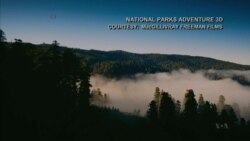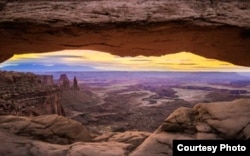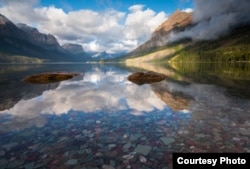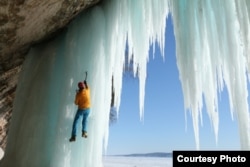A little over 10 percent of the total area of the United States is designated as protected land.
It's a decent amount, though some countries set aside as much as 30 percent of their land.
But what the U.S. lacks in percentages is made up in natural beauty.
The U.S. National Park Service looks after much of this land and this year the Agency is celebrating its 100th anniversary.
What better reason to hire an award-winning film team and send them out into the wild for nine months, have them travel to half of the almost 60 national parks across the country and capture some of the most beautiful and pristine landscapes in America.
Shot in spectacular IMAX® 3D, the film "National Parks Adventure" explores the history of the parks and takes viewers on a visually stunning journey as seen through the eyes of three adventurers; world-renowned mountaineer Conrad Anker, artist Rachel Pohl and adventure photographer Max Lowe.
The friends hiked among giant Sequoia and Redwood trees in Yosemite National Park in California, biked along the rust-colored canyons in Moab, Utah and climbed the sheer walls of Devils Tower in Wyoming.
Director Greg MacGillivray said he wanted to commemorate the parks' centennial because he is a huge fan of America's parks and felt that it would be "a great idea to celebrate that 100 years by paying tribute to the parks that we love in a big adventure film.”
“I think what I really want the audience to feel is a certain deal of reverence for the parks,” he said.
National parks history
The film delves into the history of how the parks came to be and how, mainly because of the courageous efforts of two men, those natural wonders were saved, and got to remain much the same as they were before.
One hundred years ago some of America’s most beautiful natural spaces were at risk of being destroyed by ranchers, developers and loggers. But thanks to President Theodore Roosevelt and naturalist John Muir whose characters are depicted in the film by actors, those precious lands that both men had grown to love were designated as national parks to be protected and preserved for future generations.
The film crew visited some of those historic places, and helped re-create some of the known history with archival photos and re-enactments.
Producer Shaun MacGillivray calls the film "a road trip."
"It’s being able to showcase from Yellowstone to Yosemite and the Grand Canyon to the Tetons; these amazing places, while connecting them through individual characters,” he said.
Protected creatures
The film also points out that as the lands became protected, so too did the animals who lived there...from the alligators in Florida's Everglades to the wild prairie dogs who live and thrive near Devils Tower and the bears that live and hunt in the wilds of Alaska.
“One of my favorite scenes in the film is when we went out to Katmai, Alaska and filmed bears catching salmon," Shaun MacGillivray said.
"It was an incredible experience where our team was there for three weeks straight and it wasn't until the last day that we are able to get these bears -- in an unbelievable sun -- catching a salmon," he added.
"You feel like you're there; you feel like you're with these bears."
And that is the main point of the film it seems, to capture in breathtaking IMAX 3-D format, clear, detailed images for the benefit of people who would not necessarily have an opportunity to see them for themselves.
Greg MacGillivray said the parks were a perfect subject for the IMAX 3-D format.
“The audience can feel like they've been there," said Greg MacGillivray, "and so the film really does convey for the audience the best of the parks."
Actor, director and environmental activist Robert Redford, who narrates the film, agrees.
“'Cause when you go to the national parks, it's a great expanse of nature and it surrounds you," he said, "so IMAX is probably the most logical place to recreate that experience for people who can't go there, haven't been there and maybe will still go there.”
The team endured extreme weather conditions and difficult terrain to capture the amazing sights — and sounds — of America’s natural treasures.
And at least one sequence shot at a frozen waterfall in Pictured Rocks National Lakeshore in Michigan brought home the reality of working and playing in wild places. In one particularly chilling sequence, one of the climbers loses his footing while scaling an icy wall. It's a heart-stopping moment to see him dangling by an ice axe while he resets his footing.
Here the climbing and film crew camped out on frozen Lake Superior, just another day on the job for a dedicated group.
“Getting the camera into location for the climbing shoots was pretty challenging," said Anker. "Especially on Devils Tower. It's a sheer cliff and we had to get the camera above us to get that top down view of the climbers.”
But, he added, “The viewer having seen “National Parks Adventure” will hopefully understand the diversity and the breadth of the National Park system here in the United States ... and if they leave with that inspiration then we’ll have accomplished what we set out to do.”











